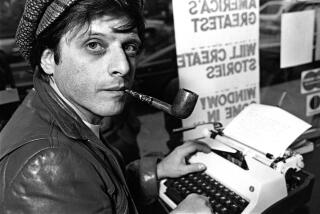Will Eisner, 87; Pioneer of Graphic Novels
- Share via
Will Eisner, a titan of the comics world who in the 1940s brought to life characters such as The Spirit and Sheena, the Jungle Girl, and three decades later shifted into far more realistic and gritty terrain by pioneering the graphic novel, has died. He was 87.
Eisner died Monday at Florida Medical Center in Lauderdale Lakes, Fla., after suffering complications related to a quadruple heart bypass he underwent last month, according to Denis Kitchen, Eisner’s publisher for three decades and his agent in recent years.
The artist’s body of work, which began in earnest in the 1930s with the swashbuckling “Hawks of the Sea,” will be capped by the May release of “Plot,” a graphic novel that is his personal take on the history of the Protocols of the Elders of Zion as a weapon against Jews. The book will be published by W.W. Norton & Co.
Eisner’s work was marked by sophistication; his Spirit newspaper strips are still hailed as a melding of German Expressionist imagery and the sly worldview of Hollywood’s screwball comedies. He was constantly experimenting in the use of panels, lettering and even format. The Spirit was published in newspapers from 1940 to 1952 in a self-contained, four-color insert.
In similar fashion, Eisner would test the boundaries of comic books in 1978 with “Contract With God,” a collection of illustrated stories about real people that he called “a graphic novel,” marking a new area of ambition in comics.
Eisner devoted his recent decades to graphic novels about poverty, aging and despair in such titles as “The Tenement” and “The Invisible People.” Since “Contract With God” came out, he had published about a book a year.
“My stories are all centered around the human being, the business of survival, of struggling against the forces of life itself,” Eisner said in one interview. “We’re dealing with impossible and unbeatable forces, not a single monster. My interest is not the superhero, but the little man who struggles to survive in the city.”
Author Michael Chabon, who fictionalized Eisner in his Pulitzer Prize-winning novel, “The Amazing Adventures of Kavalier & Clay,” said Eisner was really the only one at the time to see comics for what they were: a medium in which an artist could find new ways of telling stories.
“There’s no question, he [was] one of the most important figures in comic books,” Chabon said.
Since 1988, the comics industry’s top award has been called “the Eisner.” Eisner’s textbooks, “Comics and Sequential Art” and “Graphic Storytelling,” are required reading in the comics field and dovetail with his teachings at the New York School of Visual Art in New York City.
Art Spiegelman, who won the 1992 Pulitzer Prize for “Maus,” a graphic novel about the Holocaust, once called Eisner a “genius cartoonist who changed the vocabulary of comics.” Cartoonist Jules Feiffer declared Eisner a national treasure.
This year, several museum exhibitions about Eisner have been planned, and two books concerning him are scheduled to be published: “Eisner/Miller,” a dialogue between Eisner and comics artist Frank Miller, and “Will Eisner: A Spirited Life,” a biography by Bob Andelman.
Eisner was born March 6, 1917, in Brooklyn. His father, an emigre from Vienna, painted stage sets and encouraged his son’s artistic aspirations. Eisner attended De Witt Clinton High School in the Bronx (along with friend Bob Kane, who would create Batman), and his first work was published in the school newspaper.
In what became industry legend, Eisner started a comics production company with friend Jerry Iger in 1937. Their $15 investment bought three months’ rent on East 41st Street for their firm, Eisner & Iger.
“Like brokers who forecast a sudden demand for pork bellies, we believed that pulp publishers, who were repackaging newspaper comic strips into magazine-size formats, were going to run out of them at any minute,” Eisner recalled in the New York Times Book Review in 1990. That prediction would be a solid one.
The national demand for comics, which would be spurred by the 1938 advent of Superman, exploded. Eisner was writing and drawing under five names “in what would soon become a kind of artistic ghetto in which people with authentic, if offbeat, talents had to suffer the disdain of the mainstream,” he once wrote. His 1986 graphic novel, “The Dreamer,” is a roman a clef about those early years.
Recruiting a number of young peers, including Kane, Jack Kirby and Lou Fine, the Eisner & Iger studio became a factory, and its output included Sheena, Blackhawk and Dollman. The shop did have one historic misstep -- Eisner declined a crude character sketch presented by a pair of youngsters, Jerry Siegel and Joe Shuster, who took their Superman pitch elsewhere.
The Eisner/Iger partnership ended in 1939 when a newspaper syndicate hired Eisner to create a 16-page newspaper supplement featuring what would become his best-known character, The Spirit. Unlike other heroes, The Spirit wore a suit and, like a pen-and-ink Cary Grant, was by turns dashing, funny and feckless. He roamed back alleys instead of a gleaming Metropolis,
When presenting a lifetime achievement award to Eisner in 2002 at the National Foundation for Jewish Culture, Spiegelman said: “What made Superman popular was its fantasy. What made The Spirit popular was its smell of reality, its sophisticated style, its ambience and its stories.”
In 1942, a draft notice forced Eisner to abandon The Spirit. In the Army, he made strips and posters, among them the cautionary pratfalls of Joe Dope. His studio hands, among them Feiffer and Fine, took over The Spirit.
After the war, Eisner founded American Visuals Corp., which produced art for such clients as RCA Records, the Baltimore Colts and New York Telephone. In 1952, he retired The Spirit and dedicated his labor to advertising and marketing instead of storytelling.
His interest in comics was reignited in the 1970s when he saw the underground works of artists such as Robert Crumb. Eisner went back to the drawing board and created his first graphic novel.
He is survived by his wife, Ann, and his son, John. Services were pending Tuesday.
*
To see more of Eisner’s work, go to latimes.com/eisner.
More to Read
Sign up for our Book Club newsletter
Get the latest news, events and more from the Los Angeles Times Book Club, and help us get L.A. reading and talking.
You may occasionally receive promotional content from the Los Angeles Times.







